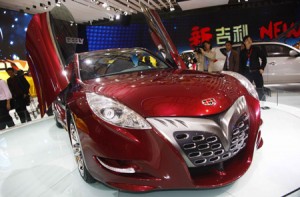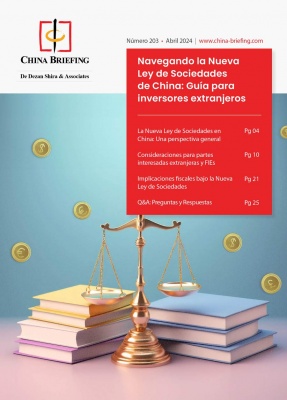China Sector Watch: Automobiles
 This ongoing series takes an in-depth look at the industries that are shaping the Chinese economy today.
This ongoing series takes an in-depth look at the industries that are shaping the Chinese economy today.
By Joyce Roque
May 29 – It was in 1901 that automobiles first came to China, mostly in the streets of Shanghai. Then, automobiles were usually imports from America and used by foreigners. During that time, China did not have enough paved roads to make the use of automobiles convenient for everyone. It would only be in 1956 that the automobile factory, First Automobile Works, would begin making cars in the country.
It is during this period that today’s local automobile manufacturers would trace their roots – the Nanjing Automobile Corporation, Shanghai Automotive Industry Corporation (SAIC), China National Heavy Duty Truck Group and the Beijing Automotive Industry Holding Corporation.
After the Cultural Revolution, China’s reforms led to a full-throttle towards capitalism. Chinese citizens were encouraged to go out and make their own fortunes. Industries were laid open to foreign investment and export boomed. This would feed China’s double digit growth in the next years and fatten its foreign reserves.
The economic reforms included inroads being made for its automobile industry. A first-time visitor to Shanghai will notice the proliferation Volkswagen cars on the street, a lot of these models even used as cabs.
The German company was an early adopter and saw the potential of the Chinese market. It was one of the first foreign entrants to China’s automobile markets in 1978 before partnering with the SAIC to form a joint venture –the Shanghai Volkswagen Automotive – on October 1984. Volkwagen Group China also partnered with FAW in 1991. Today, VW maintains a strong presence in the country and is China’s top carmaker overall.
It will continue its partnership with the Shanghai Volkswagen Automotive until 2030.The Shanghai Volkswagen joint–venture makes cars under the Volkswagen and the Skoda brands with SVW offering six model series, including Volkswagen Santana, Santana Vista, Passat, Polo, Touran, Lavida and Skoda Octavia.
Following VW, the top 5 car brands in the country are Hyundai, Toyota, Honda and Nissan. Unlike General Motor’s troubled finances in the United States, its Chinese subsidiary has been smarter to adopt to the needs of the local market making it one of the company’s biggest earning global subsidiaries.
Media reports dated early May say that GM will be moving its manufacturing operations out of the United States to cut on costs. GM is planning to sell Chinese-made vehicles to the U.S. and North American market; mainly small cars like the Chevrolet Spark.
By 2011, GM will begin importing 17,335 cars until eventually raising the volume to 51,546 cars by 2014. It will be an ironic turn of events the first importer of Chinese-made cars will be coming from a top American car manufacturer.
The Shanghai Auto Show
If last April’s auto show in Shanghai is any barometer, major and local car brands are now looking at the Chinese market with renewed interest. China’s automobile market was the only one that showed promising growth in what has become a sobering reality in a global market hampered by an economic crisis- depressed demand.
For the first four months of the year, China was the largest automobile market in the world with total sale of 3.84 million vehicles overtaking the United States. China may even become the largest car market in the world by the end of the year given the United States’ economic crisis which squelched consumer demand.
The auto show provided a glimpse of what the future of the Chinese market would be. Global car brands competing with the best of what the local market can offer. Local brand, Geely introduced its new high-end Englon. State-owned Chery Automobile Co., maker of the best-selling subcompact QQ, introduced its new sedan, Riich, for more affluent buyers.
It was during the eve of the Shanghai auto show that Porsche also unveiled its luxury sedan, the Panamera. A first for a company that in the past would formally enter a new market segment only at auto shows in the United States or Europe.
German automaker Mercedes-Benz showcased its roster of 35 models. The largest number of cars brought in by the brand just for the Chinese market. The car brand is doing well in China with more than 11,000 units sold during the first quarter of the year.
Honda predicts that its Chinese sales will expand by 10 percent to 520,000 units. For the Shanghai Auto Show, GM brought in 37 vehicles and concept cars with the hopes of growing sales to 2 million units in the next five years. For the first quarter of the year, GM sold 363,701 vehicles in China, an increase of 16.8 percent from the same period last year.
It is clear that all major car makers are upbeat on the prospects of the Chinese market. In March, auto sales increased by 37 percent. It was during this time that the Ministry of Finance announced new car subsidies for farmers replacing their old vehicles worth as much as US$731.
Beijing has said it is targeting a sales figure of 10 million vehicles by the end of the year and released a US$700 million package to help the auto industry. Already the government has implemented measures that would encourage more people to buy cars as part of its efforts to increase local demand. These also include tax breaks and special incentives for companies producing fuel-efficient and low-emission vehicles. Purchase tax was cut by half in January for cars with engines below 1.6 liters.
The next Detroit?
The global economic crisis can be seen as both a boon and a bane for China’s economy. On one hand, it has crippled exports, a major source of China’s GDP at 40 percent in 2007. This has led to widespread factory closures in the Guangdong Province and an alarming jump in unemployment. On the other hand, the crisis has added urgency for China to implement needed reforms and finally change its economic strategy to include a focus on the domestic market and not just solely rely on exports.
For its burgeoning auto market, Beijing is aiming to make the jump at being the world’s leading producer of hybrid and electric vehicles in the next three years. A cleaner and more competitive version of America’s Detroit may be on its way.
China is providing research subsidies for electric car designs and tax incentives for consumers buying alternative energy vehicles. A US$220 million package will be available to provide funding for companies wanting to upgrade their technology with an emphasis on alternative-energy vehicles.
China wants to raise its annual production capacity to 500,000 hybrid or all-electric cars and buses by the end of 2011, from 2,100 last year, government officials and Chinese auto executives told The New York Times.
The government has gone a step further by providing subsidies worth US$8,800 each for taxi companies and local government agencies buying alternative-energy vehicles. Accordingly, state electricity grid has been tasked to place electric car charging stations in major cities like Beijing, Tianjin and Shanghai.
Conclusion
China’s plan to focus on its alternative-energy vehicles will have several benefits should the campaign prove successful. The most obvious benefit is it will remedy the issue of urban pollution by reducing greenhouse gases. Moreover, it will decrease China’s reliance on oil which is still bought from Middle East suppliers and travels via sea routes vulnerable to foreign military intervention.
The economic crisis also gives Beijing the opportunity to turn one of its top local brands into a world-renowned one. Be it Chery, Geely or BYD, the tougher economic climate will be better for the local industry as a whole by consolidating the weaker manufacturers with the strong ones. Chinese car manufacturers are still plagued by quality-control issues. Some local auto brands produce outright copies of popular foreign models without the benefit of marketing research or testing. This time, while foreign car manufacturers benefit from more experience, local car brands will have the advantage of being run and favored by the government.
The push towards the development of the auto industry also complements China’s plans to improve its highway system. The economic stimulus plan announced last year is mostly aimed at infrastructure projects. Currently, China has built 30,000 kilometers of highways. Sales demand for vehicles are also predicted to be moving inland because of an emerging trend for more affordable, small cars coming from outside China’s big cities.
What China is doing now as a whole and more so for the auto industry, is to create value in a time of serious crisis; hopefully emerging stronger if not unscathed.
- Previous Article Hong Kong Adds HK$16.8 Billion to Stimulus Plan
- Next Article Shanghai to Spend US$45 Billion for Expo
























